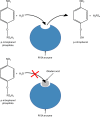Use of biosensors for the detection of marine toxins
- PMID: 27365035
- PMCID: PMC4986468
- DOI: 10.1042/EBC20150006
Use of biosensors for the detection of marine toxins
Abstract
Increasing occurrences of harmful algal blooms (HABs) in the ocean are a major concern for countries around the globe, and with strong links between HABs and climate change and eutrophication, the occurrences are only set to increase. Of particular concern with regard to HABs is the presence of toxin-producing algae. Six major marine biotoxin groups are associated with HABs. Ingestion of such toxins via contaminated shellfish, fish, or other potential vectors, can lead to intoxication syndromes with moderate to severe symptoms, including death in extreme cases. There are also major economic implications associated with the diverse effects of marine biotoxins and HABs. Thus, effective monitoring programmes are required to manage and mitigate their detrimental global effect. However, currently legislated detection methods are labour-intensive, expensive and relatively slow. The growing field of biosensor diagnostic devices is an exciting area that has the potential to produce robust, easy-to-use, cost-effective, rapid and accurate detection methods for marine biotoxins and HABs. This review discusses recently developed biosensor assays that target marine biotoxins and their microbial producers, both in harvested fish/shellfish samples and in the open ocean. The effective deployment of such biosensor platforms could address the pressing need for improved monitoring of HABs and marine biotoxins, and could help to reduce their global economic impact.
Keywords: biosensors; harmful algal blooms; marine biotoxins; marine monitoring; shellfish poisoning.
© 2016 The Author(s). Published by Portland Press Limited on behalf of the Biochemical Society.
Figures


References
-
- Alexander J., Auðunsson G.A., Benford D., Cockburn A., Cravedi J., Dogliotti E., et al. Opinion of the Scientific Panel on Contaminants in the Food Chain on a request from the European Commission on marine biotoxins in shellfish–okadaic acid and analogues. EFSA J. 2008;589:1–62.
-
- Dyson K., Huppert D.D. Regional economic impacts of razor clam beach closures due to harmful algal blooms (HABs) on the pacific coast of Washington. Harmful Algae. 2010;9:264–271. doi: 10.1016/j.hal.2009.11.003. - DOI
-
- Joint Group of Experts on the Scientific Aspects of Marine Environmental Protection (GESAMP) Protecting the oceans from land-based activities. GESAMP Rep. Stud. 2001;71:1–168.
Publication types
MeSH terms
Substances
LinkOut - more resources
Full Text Sources
Other Literature Sources

